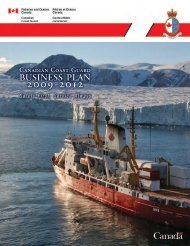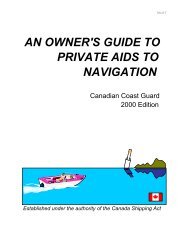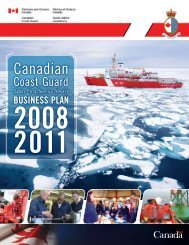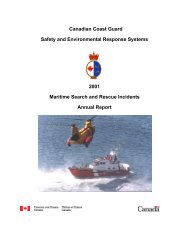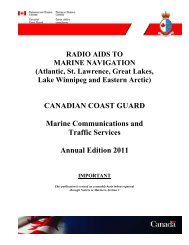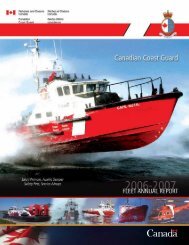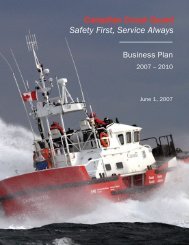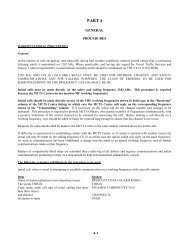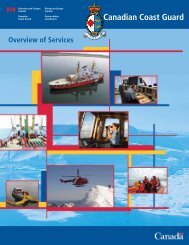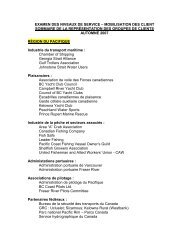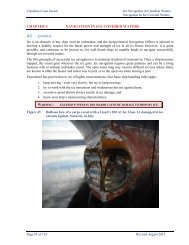RADIO AIDS TO MARINE NAVIGATION - Canadian Coast Guard
RADIO AIDS TO MARINE NAVIGATION - Canadian Coast Guard
RADIO AIDS TO MARINE NAVIGATION - Canadian Coast Guard
You also want an ePaper? Increase the reach of your titles
YUMPU automatically turns print PDFs into web optimized ePapers that Google loves.
GMDSS Sea Areas – Canada<br />
In Canada, as a result of consultations with the <strong>Canadian</strong> marine industry, it has been decided to implement sea areas A1 on<br />
the east and west coasts. Outside of A1 will be an A3 sea area with an A4 sea area in the Arctic.<br />
Consideration was given to the implementation of an A2 sea area, but due to budgetary constraints and the marine<br />
industry’s preference for sea areas A1 and A3, sea area A2 is not being planned at this time.<br />
Communications between GMDSS Vessels & Non-GMDSS Vessels<br />
Since February 1, 1999, GMDSS larger ships have been maintaining an automated listening watch on GMDSS VHF/DSC<br />
Ch 70 and MF/DSC 2187.5 kHz. This at times creates the situation, where vessels fitted with traditional, non-GMDSS<br />
radio equipment, may have had difficulties alerting or contacting a GMDSS ship. The <strong>Coast</strong> <strong>Guard</strong> is addressing this by<br />
monitoring both GMDSS and traditional distress frequencies. <strong>Canadian</strong> <strong>Coast</strong> <strong>Guard</strong> MCTS Centres will continue to<br />
monitor 2182 kHz and CH 16 for distress, urgency, safety and calling purposes for the foreseeable future. Further, the<br />
<strong>Coast</strong> <strong>Guard</strong> and Transport Canada encourage all vessels to fit VHF/DSC in the interest of increased safety.<br />
Important Safety Notice concerning VHF/DSC<br />
After having received a distress, urgency or safety broadcast announcement on VHF/DSC Channel 70 the VHF/DSC<br />
equipment will automatically switch the DSC radio to VHF Channel 16 for the subsequent voice announcements. Mariners<br />
who are required by the VHF Practices and Procedures Regulations to monitor a specific VTS sector frequency should<br />
return the radio to the appropriate working frequency after determining, on Channel 16, the impact of the VHF/DSC alert<br />
broadcast announcement on their vessel's’ operations.<br />
It has been determined that vessels maintaining a listening watch on a VTS sector frequency, per the requirements of the<br />
VTS Zone Regulations may, if navigating in congested waters, temporarily discontinue DSC watchkeeping on VHF/DSC<br />
Channel 70 until the required manoeuvre has been completed.<br />
Vessels inadvertently or accidentally transmitting a distress/urgency/safety broadcast on VHF/DSC must cancel the<br />
distress/urgency/safety broadcast on VHF Channel 16. Intentionally sending a false distress alert carries penalties under<br />
both the Canada Shipping Act and the Radiocommunication Act.<br />
VHF/DSC equipment must be programmed with the correct Maritime Mobile Service Identity (MMSI) numbers (reference<br />
Radio Station licensing and MMSI numbers section in Part 4 also reference page 1-5 for the MCTS Centres’ MMSI<br />
numbers).<br />
<strong>Canadian</strong> <strong>Coast</strong> <strong>Guard</strong> Marine Communications and Traffic Services (MCTS) Centres<br />
To help ease the transition to GMDSS and bridge the communication gap between the two systems, <strong>Canadian</strong> <strong>Coast</strong> <strong>Guard</strong><br />
MCTS Centres will continue to monitor the current distress and safety channels VHF Ch 16 and MF 2182 kHz for the<br />
foreseeable future. Once Canada’s sea areas have all been implemented, lower cost DSC equipment is available, and it is<br />
determined that these services are no longer required, these listening watches may be discontinued. This decision will be<br />
evaluated at that time.<br />
To supplement the broadcasting of Maritime Safety Information (MSI) on NAVTEX and INMARSAT EGC, MCTS<br />
Centres will continue safety broadcasts using the existing VHF continuous marine broadcast system.<br />
4-10



